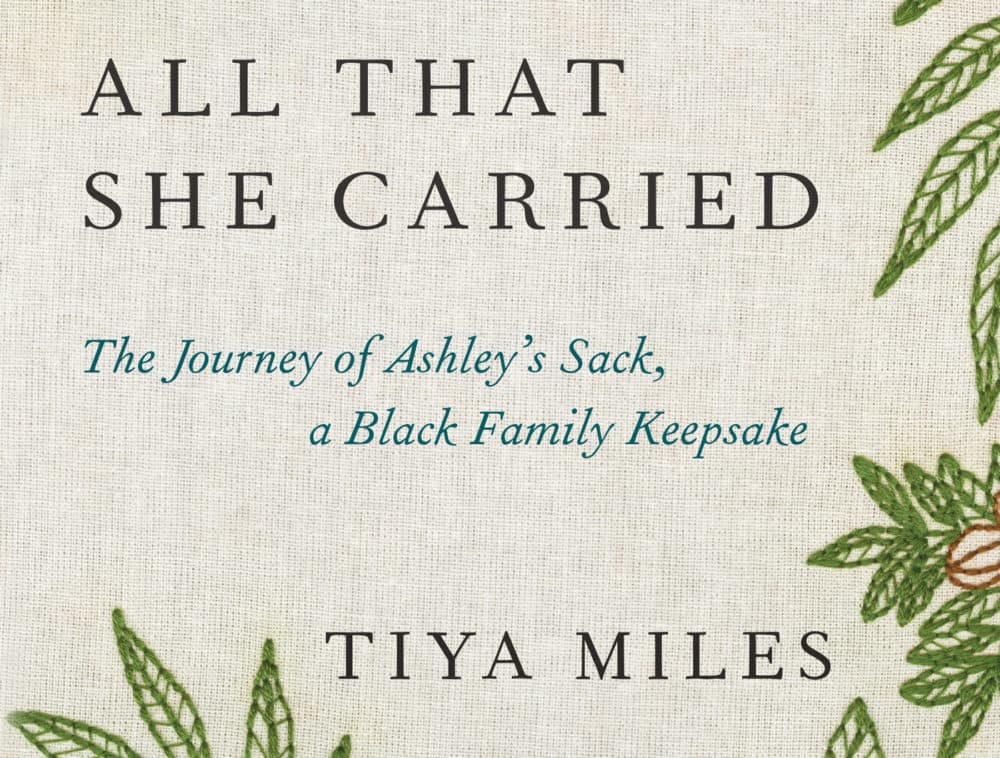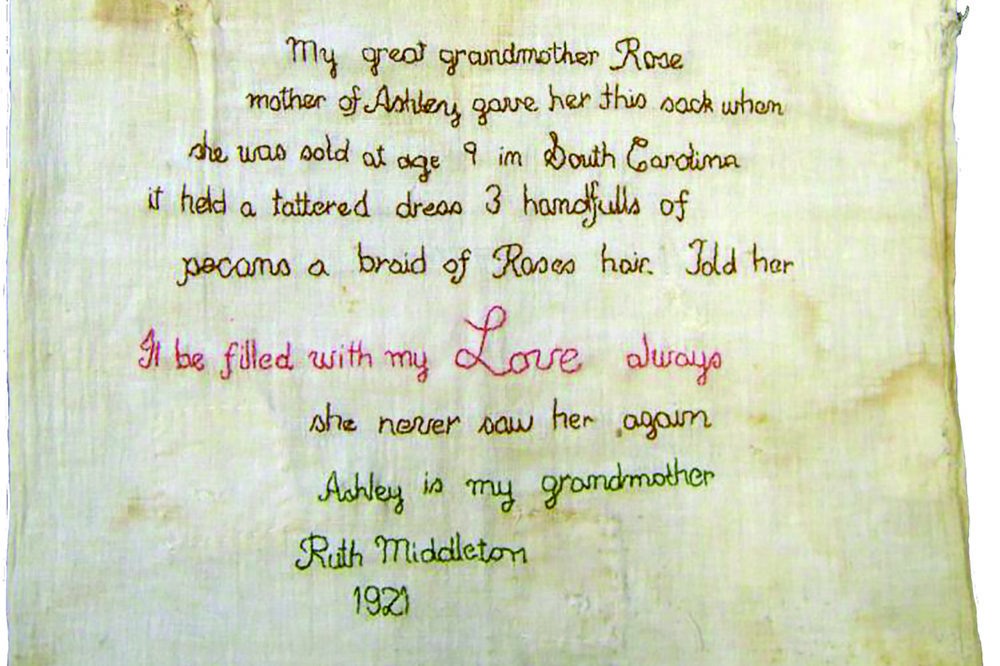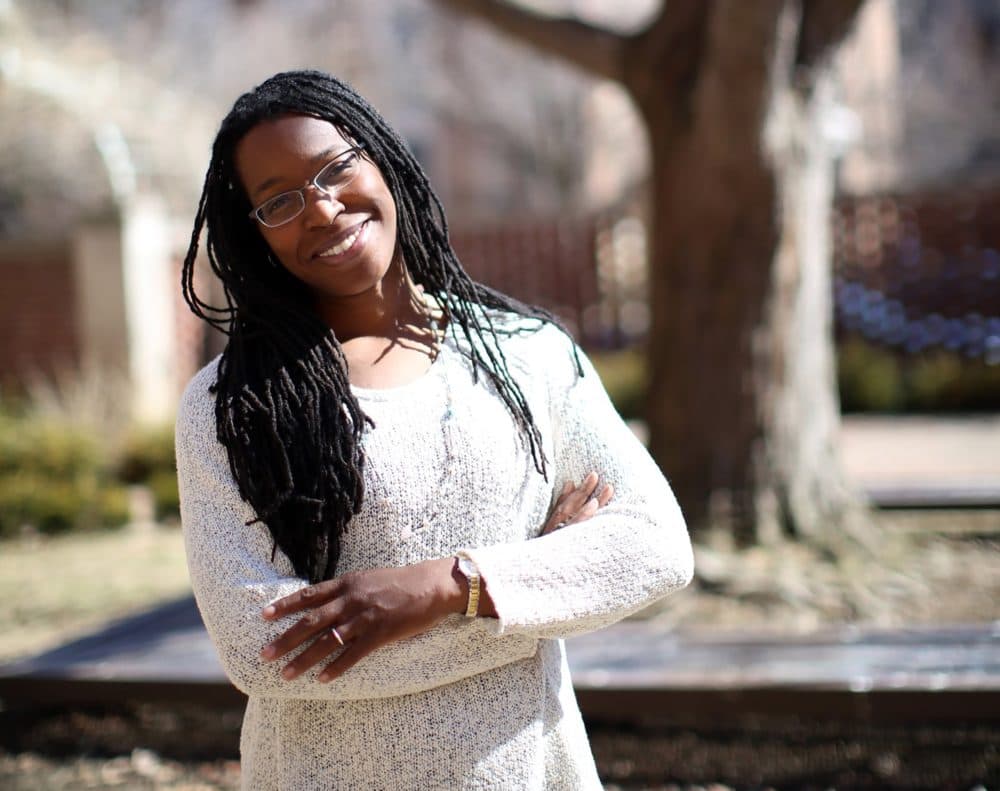Advertisement
'All That She Carried' tells the story of generations of Black women and the love that binds them

Editor's note: This segment was rebroadcast on Feb. 7, 2022. Click here for that audio.
A simple cotton sack is the subject of a book that's a finalist for the National Book Award.
The “moving and mysterious” object captivated author and historian Tiya Miles, who combed through records and wrote "All That She Carried: The Journey of Ashley's Sack, a Black Family Keepsake."
A few lines stitched on the bag weave together three women, their lives, their generations, their love and their loss.

Miles was able to identify Rose to a “very near best guess argument” along with another anthropologist tracing the family, she says. Going off of little records — often the case with enslaved women in the antebellum period between 1832 and 1860 — they were able to determine Rose and Ashley were likely separated while Rose was enslaved in Charleston, South Carolina, in the 1850s.
The historical inference is that Rose handed the sack down to her daughter, Ashley, at the auction block or around that time before they were split up.
As sad as the story is, Miles says people have strong emotional reactions to seeing the sack — it’s been on display at the National Museum of African American History and Culture — because they recognize the family survived and successfully passed the object through the generations.
“The story is so seemingly simple that I think it goes right to the heart of people's own feelings and thoughts about their relationships,” she says. “One person told me about what it had been like to be an adoptive parent, actually, and how seeing the sack and reading my book helped him to think about that initial separation of his adoptive child from their birth mother.”
Advertisement
A tattered dress, three handfuls of pecans and a braid of Rose’s hair were packed in the sack. The hair was especially significant as a “visual and tactile representation of Rose herself,” Miles says.
The braid humanizes a dehumanizing chapter in American history. Black hair has been maligned throughout U.S. culture, Miles says, “so there is an additional layer of meaning here, which is indicative of uplifting those aspects of ourselves that have actually been subjugated in American culture that come through this gift of the braid.”
Clothing, weaving and other textile work was a way for women to preserve history and communicate social status, religious beliefs and personality — such as the ragged dress.
These items were incredibly valuable considering enslaved Black women had little to no property to pass down to their children. “Enslaved Black women were themselves legally defined as property,” she says.
In Rose’s lineage, it was Ruth Middleton who heard the story of her family and stitched those words onto the sack in 1921.
In the stitching, Middleton claims Ashley as her grandmother in real time — “Ashley is my grandmother” — and includes the words “told her,” which Miles says suggests that Middleton is repeating a story she was personally told by Ashley.
Today, the country continues to have challenging conversations about race and history. In Virginia, Confederate statues and monuments are coming down and street names are being changed. Miles draws a contrast between these massive Confederate monuments and the sack.
These statues signal to all who see them the values of the Confederacy, Miles says.
“If those values were still in play, I would not be someone who was autonomous and free and had the right to vote,” she says.
Debates over the removal of these arguments have been divisive, even violent. In comparison, Ashley’s sack represents something different — something more powerful than a monument.
“It's not huge. It's not made of stone. It's not in the middle of a town square,” she says. “And yet it speaks as loudly, I think, in part because it is clearly expressing the importance of love and care and continuity and resilience.”

Book Excerpt: 'All That She Carried'
By Tiya Miles
Prologue: Emergency Packs
Rose was in existential distress that fateful winter when her would-be earthly master, Robert Martin, passed away. The place: coastal South Carolina; the year: 1852. We do not know Rose’s family name, or the place of her birth, or the year of her death. Such is the case with the vast majority of African and Indigenous American women who were bought, sold, and exploited by the hundreds of thousands. But we can be sure that Rose faced the deep kind of trouble that no one in our present time knows and only an enslaved woman has seen. Rose knew that she or her little girl, Ashley, could be next on the auction block, the cold device enslavers turned to when their finances faltered.
Ripping families apart was a common practice in a society structured by—and, indeed, dependent on—the legalized captivity of people deemed inferior. And sale could not have been the end of Rose’s worries or the worst of her fears. She must have dreaded what could occur during this relocation and after: the physical cruelty, sexual assault, malnourishment, mental splintering, and even death that was the lot of so many young women deemed slaves. Rose and Ashley’s life together, already encased by swales of suffering, could be torn asunder in a matter of moments with the stroke of a pen. Their lives apart portended even worse without the bonds of family. Rose adored this daughter and desperately sought to keep her safe. But what could safety possibly mean in a place, at a time, when a girl not yet ten years old could be lawfully caged and bartered? What would Rose do to protect her child? What could she do as an unfree woman with no social standing, political power, economic means, or cultural currency positioned in the trenches of unpredictable and insurmountable difficulty?
The kind of fix Rose was in—life-threatening and soulstealing—was one that Black women like her had continually encountered over more than two centuries of life in America. It was a fix articulated by the few enslaved women who managed to escape and tell their stories in the nineteenth century and, later, by Black women thinkers and artists who drew sustenance from the writings of these cultural ancestors in the generations that followed, including our own. How does a person treated like chattel express and enact a human ethic? What does an individual who is deeply devalued insist upon as her set of values? How does a woman demeaned and cowed face the abyss and still give love? Rose’s actions, outlined in a single and unusual text and barely preserved for history, give us a sense. When the auction block loomed on her little family’s horizon, Rose gathered all of her resources—material, emotional, and spiritual—and packed an emergency kit for the future. She gave that bag to her daughter, Ashley, who carried it and passed it down across the generations.
Rose possessed inner strength and creativity even as calamity struck. Saving another’s life meant acting despite despair, and she dreamed up means of survival as well as spiritual sustenance. Surely Rose felt that what she did was far too little, much too late. Surely she feared that a battered bag would not matter enough in the end. But Rose pressed on, matching the mettle of an entrenched slave society with a glimmering will of her own. And although we cannot know exactly how events unfolded, we can conclude that Rose’s gift did affect her descendants’ lives, no matter how inconsequential her act of packing may have felt in the moment. For, three generations later, a great-granddaughter of hers, Ruth Middleton, created a remarkable “written” record attesting to Rose’s deed. Ruth’s chronicle is evidence of a long-term effect that Rose herself would never see: her female line would continue against all odds, and her will to love would be carried forward.
Rose couldn’t know how things would turn out, but she held fast to a vision. She saw her daughter alive and provided for her into the future, a radical imagining for a Black mother in the 1850s. Rose’s daughter, Ashley, realized that vision by surviving, and her great-granddaughter, Ruth, preserved their history by stitching sentences onto the surface of the sack. In the third decade of the twenty-first century, we face our own societal demons, equal in some respects to the system of slavery that would finally be slayed. The world feels dark to us, just as it must have for Rose, and like Rose, we can’t know what will happen. We think it a fantasy that we might rescue our children’s futures, or revive our democratic principles, or redeem our damaged earth. In our moment of bleak extremity, Black women of the past can be our teachers. Who better to show us how to act when hope for the future is under threat than a mother like Rose—or an entire caste of enslaved, brave women who were nothing and had nothing by the dominant standards of their time yet managed to save whom and what they loved? Rose and her long line of descendants realized that salvation depended on bearing up to the weight and promise of their baggage. We should, too.
Just as Rose and Ashley found on their forced journeys through slavery’s landscape, there is no safe place of escape left for us. The walls of the world are closing in. We need to get out of here in a hurry. We need to get out of these frames of mind and states of emotion that elevate mastery over compassion, division over connection, and greed over care, separating us one from another and locking us in. Our only options in this predicament, this state of political and planetary emergency, are to act as first responders or die not trying. We are the ancestors of our descendants. They are the generations we’ve made. With a “radical hope” for their survival, what will we pack into their sacks?
Excerpted from "All That She Carried: The Journey of Ashley's Sack, a Black Family Keepsake" by Tiya Miles. Copyright © 2021 by Tiya Miles. Republished with permission of Random House.
Julia Corcoran produced and edited this interview for broadcast with Peter O'Dowd. Serena McMahon adapted it for the web.
This segment aired on November 16, 2021.

